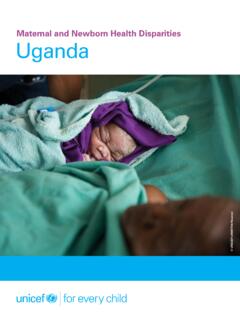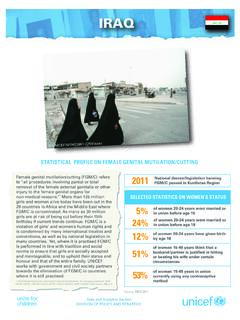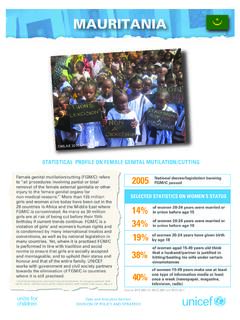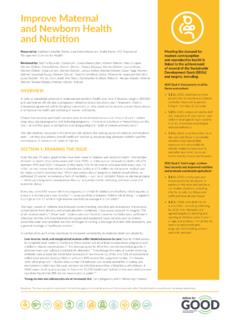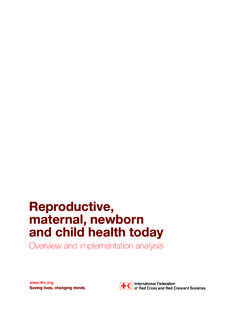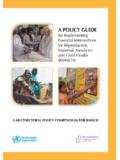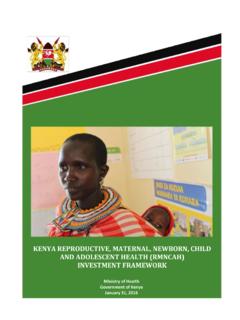Transcription of Maternal and Newborn Health Disparities Malawi
1 MalawiMaternal and Newborn Health Disparities UNICEF/UNI113438/Chagara2 MalawiKey FactsMaternal and Newborn Health Disparities in MalawiMalawi reference tableDemographic indicatorsTotal population (thousands)1201517, 215 Total live births (thousands)12015665 Total Fertility Rate (number of children per woman)120155 Adolescent birth rate (per 1,000 women 15-19)102012143 Impact indicatorsMaternal mortality ratio (per 100,000 live births)42015634 Average annual rate of MMR reduction between 1990 and 2015 (%)520152 Lifetime risk of Maternal death: 1 in x4201529 Stillbirth rate (per 1,000 total births)6201522 Preterm birth rate (per 100 live births)7201018 Under-five mortality rate (per 1,000 live births)3201564 Under-five deaths that are Newborn (%)3201534 Neonatal mortality rate (per 1,000 live births)3201522 Neonatal deaths (thousands)3201514 Service DeliveryAvailability of EmONC Services (% of minimum acceptable level)8201440 Physician density (per 1,000 population)92009< 0.
2 1 Nurse and midwife density (per 1,000 population) 3 MalawiMaternal and Newborn Health DisparitiesIn 2015, approximately 670,000 babies were born in Malawi , or around 1,800 every Among young women (aged 20-24), 31 percent gave birth by age Approximately 38 babies will die each day before reaching their first month3; 40 stillbirths occur every Neonatal mortality rate: Malawi s neonatal mortality rate (NMR)^ is 22 deaths per 1,000 live NMR in rural areas is 29 deaths per 1,000 live births and 31 deaths per 1,000 live births in urban areas for an urban-to-rural ratio of NMR among the poorest households is 31 neonatal deaths per 1,000 live births, compared to 24 deaths per 1,000 live births among the richest mortality rat es, by background characteristics, 2014 Number of neonatal deaths(per 1,000 live births)
3 205101520253035404550 Mother sEducationMother sAgeHouseholdWealthResidenceRuralPoorest No educationSecondary or higherRichest29 Urban3124423126 Aged20 34 Aged< 202526<20years>20yearsThe NMR for younger mothers (42 per 1,000 live births) is times higher than for mothers aged 20-34 (25 per 1,000 live births).2 Neonatal mortality rat efor newborns with mothers:as likely to die during the first month of life compared to those born to mothers with no :1 Newborns with bettereducated mothers are3 in10young women (aged 20-24) have given birth by age MalawiCoverage care for mothersCoverage care for newbornsOtherDemand for contraception satisfied (%)Antenatal care coverage at least 4 times (%)Skilled attendant at birth (%)Institutional delivery (%)Delivered by caesarean section (%)Postnatal care of mothers within 2 days (%)Postnatal care of newborns within 2 days (%) Newborn weighed at birth (%)Early initiation of breast-feeding (%)Exclusive breast-feeding (<6 months) (%)BCG vaccine for Newborn (%)DP T-HepB-Hib 1 (%)Tetanus protection for newborns (%)
4 Children under five who have birth certificates (%)Births by age 18 (%)#Residence 8 . ratio (urban to rural) ratio (urban to rural)Household Wealth Richest7 3 . 7. 7. wealth ratio (richest to poorest) wealth ratio (richest to poorest)Mother s ageLess than 204 3 . than 20 Mother s 4 . 2 . s education No 8 ..147. 9No educationMother s 8 . 2 . ( )( ) s education ratio (highest to lowest) . s education ratio (highest to lowest) Disparities in key Maternal and Newborn Health interventions, Malawi , 20142 Pertussis, , diseases, , 6%Other NCDs, < , , 1% asphyxiaand birth Causes of Neonatal Mortality, 2015In Malawi , the main causes of neonatal deaths in 2015 were prematurity (33 percent), birth asphyxia and trauma ( percent) and Sepsis ( percent).
5 11 Malawi 583% of deliveries in the poorest households have a skilled attendant at birth compared PoorestRichest ..95% of deliveries in the ric hest care for mothersCoverage care for newbornsOtherDemand for contraception satisfied (%)Antenatal care coverage at least 4 times (%)Skilled attendant at birth (%)Institutional delivery (%)Delivered by caesarean section (%)Postnatal care of mothers within 2 days (%)Postnatal care of newborns within 2 days (%) Newborn weighed at birth (%)Early initiation of breast-feeding (%)Exclusive breast-feeding (<6 months) (%)BCG vaccine for Newborn (%)DP T-HepB-Hib 1 (%)Tetanus protection for newborns (%)Children under five who have birth certificates (%)Births by age 18 (%)#Residence 8.
6 Ratio (urban to rural) ratio (urban to rural)Household Wealth Richest7 3 . 7. 7. wealth ratio (richest to poorest) wealth ratio (richest to poorest)Mother s ageLess than 204 3 . than 20 Mother s 4 . 2 . s education No 8 ..147. 9No educationMother s 8 . 2 . ( )( ) s education ratio (highest to lowest) . s education ratio (highest to lowest) Maternal and Newborn Health coverage indicators By residence:2 In rural areas, 44 percent of women made at least 4 antenatal care (ANC) visits compared to 51 percent in urban areas. Coverage of skilled attendance at birth is 87 percent in rural areas, compared to 94 percent in urban areas.
7 98 percent of newborns in rural and urban areas received the BCG household wealth:2 More than half of mothers among richest households (53 percent) made at least four ANC visits, compared to 40 percent of mothers from the poorest households. 83 percent of deliveries in the poorest households had a skilled attendant at birth, compared to 95 percent of deliveries in the richest households. Nearly all newborns in the richest and poorest households received the BCG vaccine (99 percent and 98 percent).Key for tables: 0-24 % 25-49 % 50-74 % 75 -100% Data not available6 MalawiSkilled attendant at birthPostnatal care of ne wborns within 2 daysAntenatal care coverage at least 4 timesPercent2868792808190444546 CentralSouthernNorthern01020304050607080 90100 Selected Maternal and Newborn Health indicators, by region, 2014By mother s age:2 45 percent of mothers aged 20-34 made at least four ANC visits, compared to 43 percent among younger mothers (aged less than 20).
8 88 percent of mothers aged 20-34 had a skilled attendant at birth, compared to 90 percent among younger mothers (aged less than 20). Among mothers aged 20-34 and mothers aged less than 20, newborns receive similar levels of postnatal care: 82 percent and 83 percent, in key Maternal and Newborn Health interventions, Malawi , 20142 Coverage care for mothersCoverage care for newbornsOtherDemand for contraception satisfied (%)Antenatal care coverage at least 4 times (%)Skilled attendant at birth (%)Institutional delivery (%)Delivered by caesarean section (%)Postnatal care of mothers within 2 days (%)Postnatal care of newborns within 2 days (%) Newborn weighed at birth (%)Early initiation of breast-feeding (%)Exclusive breast-feeding (<6 months) (%)BCG vaccine for Newborn (%)DP T-HepB-Hib 1 (%)Tetanus protection for newborns (%)
9 Children under five who have birth certificates (%)Births by age 18 (%)#National estimate7 7. 7. 6 .18 7. 2 . 7. 7. performanceHighestvalueCentralNorthernNo rthernNorthernCentralNorthernNorthernNor thernCentralSouthernSouthernNorthernCent ralSouthernSouthernHighestvalueRegional 2 . 6 .18 7. 7. (highest to lowest) (highest to lowest) Malawi 7By mother s education:2 72 percent of mothers with a higher education made at least four ANC visits, compared to only 40 percent of mothers with no education. 81 percent of mothers with no education had a skilled attendant at birth, compared to 87 percent with primary education and 99 percent for mothers with a higher education.
10 98 percent of newborns born to mothers with no education received the BCG vaccine, compared to 98 percent of mothers with a primary education and 99 percent of mothers with a higher geographic regions:2 Northern saw the highest rate of antenatal care coverage (at least four visits) of 46 percent, compared to the lowest coverage of 44 percent in Central. The region with the highest coverage of skilled birth attendance is Northern with 92 percent; the lowest coverage is Central with 86 percent a difference of times. Northern, Central, and Southern had BCG coverage of 98 better educated the mother is, the more likely she will receive critical mater nal Health services81%87%99%PrimaryNoneHigherPercen tage of women having a skilled birth attendant relative to their education levelKey for tables.

